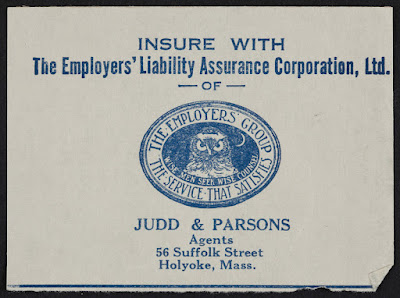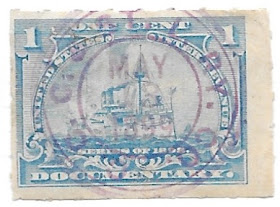Tuesday, November 29, 2022
Sunday, November 27, 2022
Cancel Correction: The Turners of Philadelphia
In the first year of this site, a 2 cent documentary stamp was featured with a prominent cancel "The Turners of Philadelphia". At the time I figured I was looking at a cancel by the German-American organization called The Turners, whose main purpose was to promote physical fitness. However, in the intervening years, and with my personal discovery of a 5/8 cent proprietary stamp with the same "The Turners" cancel, it is clear that The Turners of Philadelphia was a very different business that the German-American one. In fact, Philly Turners can be found in the proprietary focused Battlehsip Desk Reference data base. So today I will reprise that original post, and make a correction to the identity of the cancel on the R164.
The Turners of Philadelphia was a prominent proprietary medicine manufacturer. The Merck Report of April 1, 1898 featured a full page story regarding the firm that was originally published in the Philadelphian.
While I got the cancel ID wrong back in 2009, what's become clear is that it is possible to put together an interesting collection of battleship stamps cancelled by firms that used both proprietary and documentary stamps. Most commonly, the examples come from pharmaceutical companies that required them for the taxes on their products but also for financial and other taxed documentary transactions. Examples on this site include Johnson & Johnson and McKesson & Robbins, and now, The Turners of Philadelphia.
Far less common are organizations or firms whose primary business was not pharmaceuticals but might have used proprietaries on occasion. The Lake Shore & Michigan Southern Railway evidently used one cent proprietaries in a pinch when they likely couldn't get the documetary versions for their bills of lading.
Cancel for October 25: The Turners of Philadelphia

----
Cancelled 50 years after the founding of The Turners organization.

US commemorative postage stamp issued in 1948 for the 100th anniversary of the founding of The Turners. (Scott 979)
Thursday, November 24, 2022
F. E. Lane, Attorney and Mayor of Jamestown, Kansas
Tuesday, November 22, 2022
Sunday, November 20, 2022
The Estate of Amos R. Eno
As I was preparing this post, I began to reflexively hum the song The True Wheel, by Brian Eno. I couldn't resist adding the video. If intrigued, I suggest listening the entire influential album, Taking Tiger Mountain by Strategy It is possible that Amos and Brian share a distant relative.
Thursday, November 17, 2022
J. Goebel & Company, New York: Crucible Manufacterer
Julius Goebel reportedly produced crucibles to hold molten glass. At the time this stamp was canceled, his operation was on Maiden Lane in New York. In the 1920s the business would be moved to 95 Bedford Street, where you can still find evidence of Mr. Goebel and his work. Three crucibles can be seen in the crest below.
Tuesday, November 15, 2022
Mann & Eccles: Piano Dealers in Providence Rhode Island
Sunday, November 13, 2022
Fakes, Frauds and Facsimiles: The 3rd Big 4 Cancel by The J. W. Stowell Printing Company's Philatelic Advertising Bureau
Original Big 4 post from January 10, 2010:
Two-line version of the BIG 4 cancel
Thursday, November 10, 2022
New York Bankers: Henry J. Schnitzer
Henry J. Schnitzer was a foreign exchange broker in New York, who would hold a seat on the New York Stock Exchange from 1916-1918 as a partner in the banking and brokerage firm Josephthal & Company.
Sunday, November 6, 2022
R191: Varnish Bands, not Squares, and a Quadruple Surcharge
Like last Sunday, this post covers the final set of 1898 dollar value revenue stamps, but this time only quirks involving the $2 value. In particular, quirks regarding the nature of the varnish applied to the stamps that received the wrong overprint, the overprint for the "gray" $2 stamp, #R185.
What I'm calling a varnish band appears to occur across versions of R191 that have R185's numeral overprint, including R191a (single overprint) and R191d (triple overprint), and an unlisted R191 with a quadruple overprint. Examples of these 3 stamps are featured below. As you may know, some, if not most examples of the normal versions of R190 to R194 have a square of varnish in the center of the stamps that underlays a numeral overprint to help foil cancel washing and reuse.
The post last Sunday on the tendency of these stamps to change color toward the hue of the R184 to R189 raised the prospect that the varnish square might be responsible for the color changes. Whether that is the case or not, the question prompted David Thompson's inspection of his copy of R191a, a version of R191 with a single R185 type overprint. He noted that the stamp does not have a varnish square but a varnish rectangle or band across the center of the stamp, and despite appearing unused, has no gum. A scan of his stamp follows, along with a version that helps highlight the varnish "band":
So after Dave told me about his stamp, I looked at the only R191 I have that has the R185 overprint. The stamp has the same varnish band, not square, appears unused, and has no gum. It also happens to have a quadruple overprint, with a strong image to the upper north of the main overprint, a slightly weaker one on the right, and very weak image slightly above the main 2:
I have a few dozen stamps from this series in my collection which I'll need to scrutinize. Meanwhile, this column has prompted me to examine the Scott listing for R191 and I have a couple of questions:
- Except for David's copy of R191a, I've never seen this stamp. Scott has them priced at only $150 unused. Where are they? R192 missing its overprint seems very common in comparison.
- I've never seen R192b, a stamp with the R185 overprint that is printed in violet. Where is this stamp? By comparison to R191a it must be quite rare given its Scott value.
Thursday, November 3, 2022
Gilded Age Portraits: Mr. & Mrs. Henry Marquand
Henry Gurdon Marquand held a seat on the New York Stock Exchange during the Gilded Age, including the years of the 1898 Spanish American War tax period. He was extremely wealthy and had a passion for fine and expensive art, for which he built a grand Manhattan mansion in which to hang it all. And like many of New York's wealthiest at the time, he had his portrait and that of his wife painted by the go-to Gilded Age portrait artist of the time, John Singer Sargent.
Yesterday I put up Sargent's Benjamin Kissam portrait up on the right side of this site, and I started wondering how many Gilded Age brokers might have had their portraits done in oil, by Sargent or any other accomplished oil portraitist. The Marquand's were the first couple I could think of, but I'll see how many more I can find.
Meanwhile, the curious issue of Marquand cancelled stamps remains: every stamp I have ever seen cancelled by Marquand has a light, neatly applied cancel, with the stamp or stamps almost always retaining their original gum. The R188 block of 4 is one example. Here are more:
There is not much more to add, except:
- I'll be looking for on-document uses of these stamps by Marquand & Company, and
- Why would a company cancel high value stamps but not apply them to documents? Was there something nefarious happening?












































